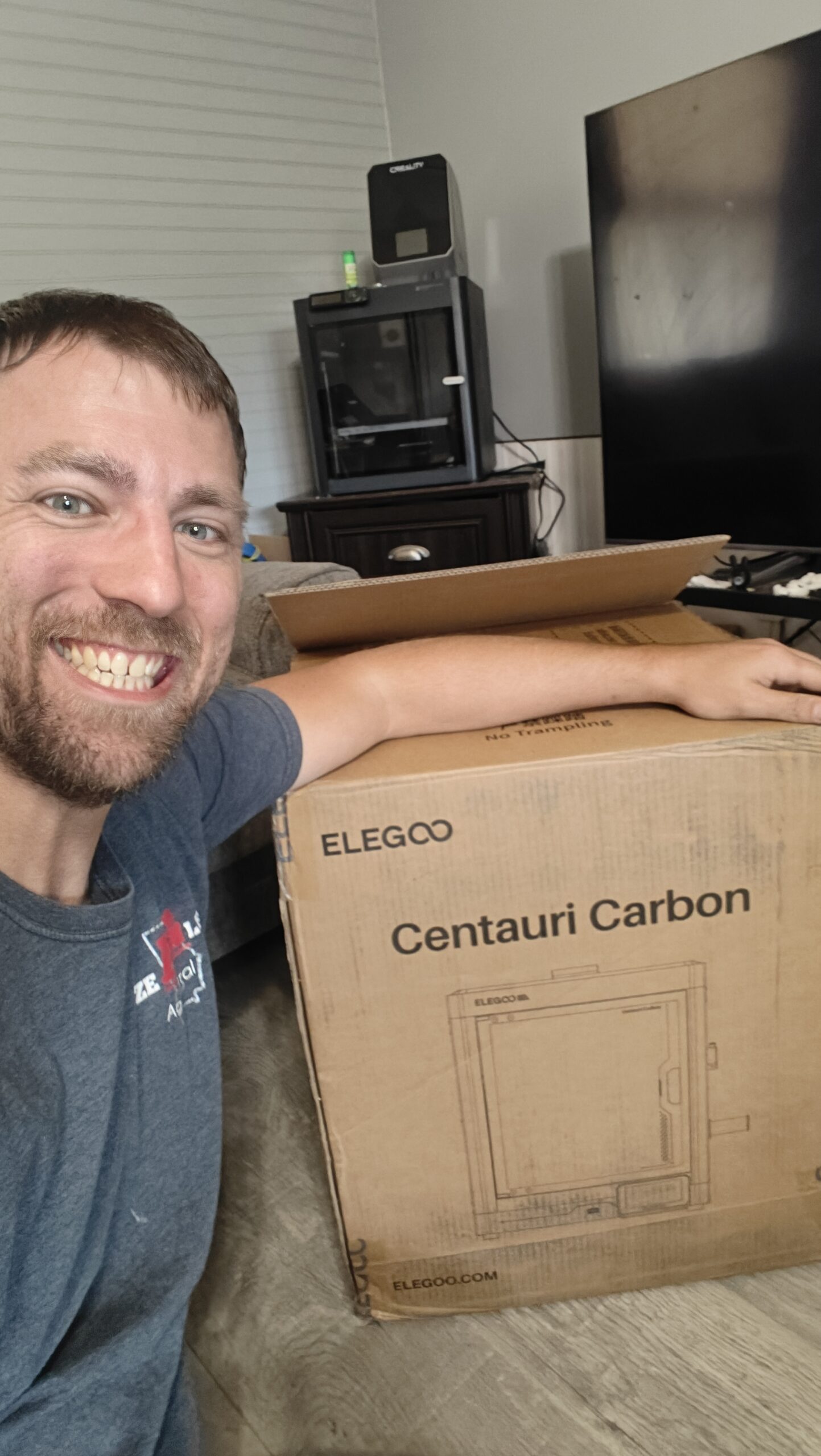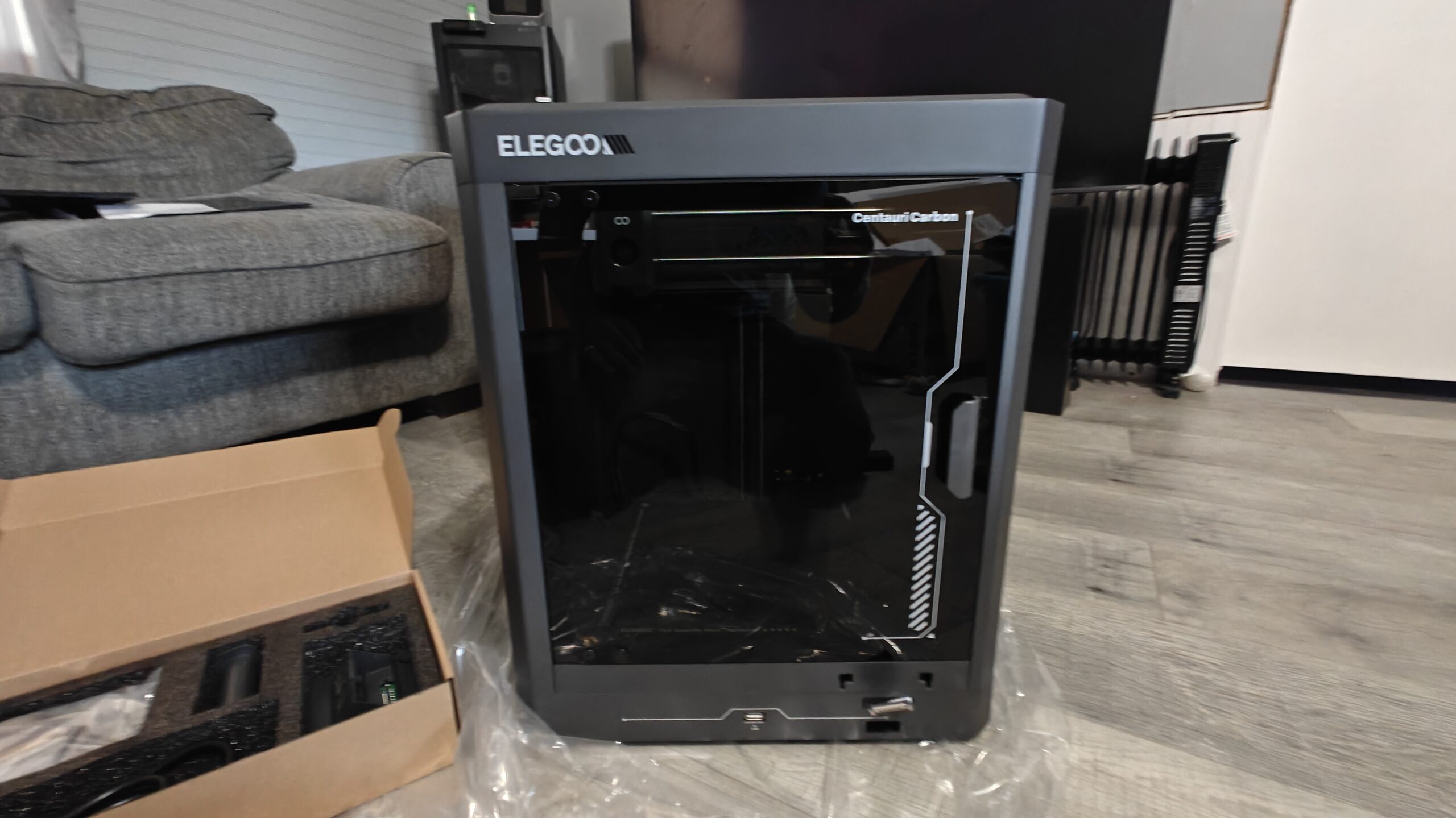Posted on: April 9, 2025
On February 17th, 2025, at exactly 9:00am EST, Elegoo launched their brand new Centauri Carbon 3D printer. And by 9:01am, my order was in. No hesitation, no second guessing — I was ready to roll the dice. After all, this printer was promising some seriously impressive specs at a price that felt almost too good to be true.
Then came the waiting. Weeks passed. Then more weeks. Somewhere between March and my growing list of tracking number refreshes, I started wondering if maybe I had imagined the whole thing. But right on cue — and no, this is not a prank — the box showed up at my door on April 1st. April Fool’s Day. Honestly, I half expected the box to be filled with packing peanuts and a note that said, “Gotcha.”
Instead, I opened the door to a glorious, tape-sealed box with the Elegoo logo staring back at me. Naturally, I did what any excited nerd would do — I took a selfie with it. Big grin, hand on the box, and full-on child-on-Christmas-morning energy. I hadn’t even cracked it open yet, and I was already feeling pretty good about the $299 gamble.
And man… the first impressions did not disappoint.
The build quality? Way better than I expected. I own a Bambu P1S — a $700 printer that has been my gold standard up to now — and this Elegoo felt surprisingly comparable out of the box. For less than half the price, it looked and felt like a serious machine. The metal frame felt solid, the double-sided build plate was a nice touch, and everything about it screamed “ready to go” without the usual DIY tinkering you’d expect in this price range. Shipping brought the total to around $330, and even then, it still feels like a steal.
After some initial testing, I can say this: the Centauri Carbon isn’t just hype — it performs. Print quality has been excellent. Clean layers, reliable adhesion, and consistent results right from the start. It feels well-engineered. Not flashy, not overhyped — just well made. I also appreciate that it supports a broader range of materials than my Bambu, which gives me more flexibility for different types of projects. That’s a big win for something in this price class.
I ran the usual test prints — Benchy, a calibration cube, a fan shroud I had been meaning to replace — and everything came out smooth and dialed in. No stringing, no warping, no layer shifts. It just worked. That’s a sentence I don’t throw around lightly when it comes to budget 3D printers. I didn’t have to tweak firmware, adjust gantry tension, or reflash anything just to get usable results. For beginners, this is huge. For experienced users, it’s just a relief.
Now obviously, this isn’t a perfect machine. The software is serviceable, but nowhere near the level of polish Bambu Studio offers. There’s no mobile app integration worth mentioning at this point, and if you’re coming from a printer that has an AMS (Automatic Material System), you might miss that convenience. Elegoo has said they’re working on their own AMS system, but there’s nothing available just yet. That said, this isn’t a dealbreaker — it’s just something to be aware of.
I also want to point out that for users who don’t want to fiddle with custom slicer profiles or network setups, this machine is surprisingly friendly. The out-of-the-box setup is minimal, the interface is straightforward, and it doesn’t punish you for wanting to just print a simple STL without a PhD in G-code. Elegoo clearly put thought into the user experience here, and that matters.
What really impresses me, though, is how much printer you get for the money. The Centauri Carbon is built like a machine twice its price. There’s something deeply satisfying about seeing those crisp layers stack up perfectly, knowing you didn’t have to shell out $800+ to get results like this. It’s not just a good beginner printer — it’s a great printer, period.
I’m not getting rid of my Bambu P1S any time soon. But for less critical prints, backup projects, or anyone looking for serious performance without a serious budget, the Elegoo Centauri Carbon is a no-brainer. I’m genuinely excited to keep printing with this thing. Time will tell how it holds up long-term, but so far, Elegoo has absolutely delivered.
Stay tuned. I’ll be sharing prints, tips, and a closer look at performance across different materials soon. And of course, the photos of the unboxing are just the beginning.
This one’s a win, folks. Big time.


Leave a Reply
You must be logged in to post a comment.